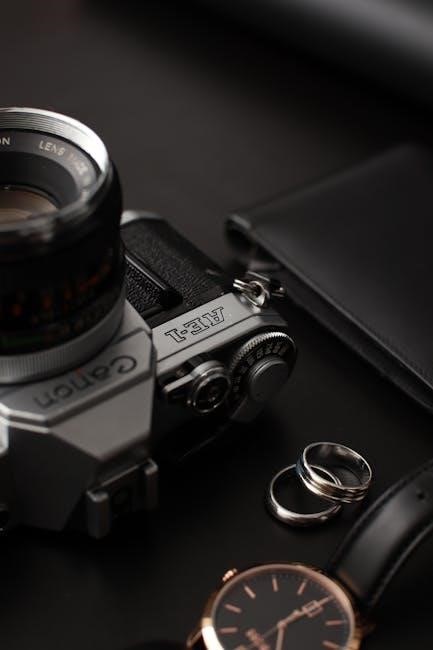
canon rebel t3 camera instruction manual
The Canon Rebel T3, known as the EOS 1100D, is an entry-level DSLR camera designed for beginners․ Released in 2011, it features a 12․2MP APS-C sensor, HD video recording, and user-friendly controls․ With a vari-angle LCD and compatibility with Canon EF lenses, it offers versatility for photography enthusiasts․ A digital field guide and instruction manual are available for mastering its features․
1․1 Overview of the Canon Rebel T3
The Canon Rebel T3, also known as the EOS 1100D, is an entry-level DSLR camera released in 2011․ It features a 12․2MP APS-C sensor, HD video recording, and a vari-angle LCD screen․ Designed for beginners, it offers a user-friendly interface and compatibility with Canon EF lenses․ The camera includes a basic instruction manual and supports firmware updates for enhanced functionality․ Its compact design and essential features make it an ideal choice for first-time DSLR users seeking to explore photography creatively․
1․2 Key Features of the Canon Rebel T3
The Canon Rebel T3 features a 12․2MP APS-C CMOS sensor, capturing crisp images with vibrant colors․ It supports HD video recording and includes a vari-angle LCD screen for flexible shooting angles․ The camera offers an ISO range of 100-6400, expandable to 12800, and uses Canon EF lenses for versatility․ A built-in flash and Scene Intelligent Auto mode simplify photography for beginners․ It also supports manual modes for advanced control․ The Rebel T3 operates on a rechargeable lithium-ion battery and allows firmware updates for enhanced functionality․
1․3 Importance of the Instruction Manual
The instruction manual is essential for maximizing the Canon Rebel T3’s potential․ It provides detailed guidance on camera functions, shooting modes, and custom settings․ Beginners benefit from clear explanations of features like ISO, aperture, and shutter speed․ Advanced users can explore firmware updates and troubleshooting tips․ The manual also covers the use of compatible accessories and software․ By referring to the manual, users can ensure proper camera maintenance and optimize their photography experience, making it an invaluable resource for all skill levels․

Getting Started with the Canon Rebel T3
Unboxing and setting up your Canon Rebel T3 is straightforward․ Charge the battery, insert the memory card, and attach the lens․ Refer to the quick reference guide for initial setup steps․
2․1 Unboxing and Initial Setup
Unboxing the Canon Rebel T3 reveals the camera body, lens, neck strap, battery, charger, and a software CD․ The instruction manual, provided in printed form, guides you through initial setup․ Insert the battery and memory card, ensuring they are securely locked․ Attach the lens by aligning the mount and twisting gently․ Power on the camera to access the menu for date, time, and language settings․ Familiarize yourself with the camera’s layout and controls before shooting․
2․2 Charging the Battery and Using the Memory Card
Charge the Canon Rebel T3’s battery using the provided charger until the indicator turns green․ Insert the battery into the camera, ensuring it clicks into place․ Use a compatible memory card (SD, SDHC, or SDXC) and format it in the camera for optimal performance․ Avoid low-capacity cards for high-resolution shooting․ Store the battery in a cool, dry place when not in use․ Always format the memory card in the camera to prevent data loss and ensure proper function․
2․3 Attaching the Lens and Basic Camera Handling
To attach the lens, align the white square on the EF-mount lens with the white index on the camera․ Gently rotate the lens clockwise until it clicks into place․ Ensure the lens lock pin engages securely․ For handling, grip the camera firmly with your right hand, supporting the lens with your left․ Avoid touching the camera’s sensor or lens elements to prevent damage․ Store the lens with a protective cap when not in use․ Always handle the camera with care to maintain its performance and longevity․

Understanding the Camera Controls
The Canon Rebel T3 features intuitive controls, including buttons, dials, and a mode dial, allowing easy adjustment of settings like ISO, aperture, and shutter speed․ The live view button enables LCD preview, while the quick reference guide simplifies operation for beginners․
3․1 External Controls and Buttons
The Canon Rebel T3’s external controls provide easy access to essential functions․ The mode dial offers various shooting modes, while the ISO, aperture, and shutter buttons are conveniently located for quick adjustments․ The live view button activates the LCD monitor, and the playback button allows instant image review․ The multi-controller and quick menu button simplify navigation, ensuring intuitive operation․ These controls enable seamless handling, making the camera user-friendly for both beginners and experienced photographers․
3․2 Navigating the Menu System
The Canon Rebel T3’s menu system is intuitive and user-friendly, allowing easy access to camera settings․ The Quick Control screen provides instant access to common settings like ISO, white balance, and autofocus modes․ Use the multi-controller to navigate and adjust options․ The menu is divided into shooting, playback, and setup tabs, making it simple to find and customize settings․ Refer to the instruction manual or digital field guide for detailed explanations of advanced features and settings․ This system ensures efficient customization and operation․
3․3 Customizing Camera Settings
The Canon Rebel T3 allows users to tailor camera settings to their preferences․ Custom Functions enable adjustments to ISO, autofocus, and metering modes․ Assign frequently used settings to buttons for quick access; Use the My Menu tab to save personalized options for easy retrieval․ The camera also supports saving custom shooting presets for specific scenarios․ Refer to the instruction manual or digital field guide for detailed guidance on advanced customization options․ This feature enhances shooting efficiency and personalizes the camera experience․

Shooting Modes and Settings
The Canon Rebel T3 offers various shooting modes, including Auto, Manual, and Scene modes, allowing users to capture images with ease․ Key settings like ISO, aperture, and shutter speed enable precise control over image quality․ The instruction manual provides detailed guidance to help users master these controls effectively․
4․1 Auto Mode for Beginners
The Auto Mode on the Canon Rebel T3 simplifies photography for newcomers, automatically adjusting settings like aperture, shutter speed, and ISO for optimal results․ This mode is ideal for those unfamiliar with manual controls, allowing users to focus on composition and lighting․ The instruction manual provides clear guidance on using Auto Mode effectively, ensuring high-quality images with minimal effort․ It’s a great starting point for learning before exploring more advanced settings․
4․2 Manual Mode for Advanced Users
Manual Mode on the Canon Rebel T3 offers full control over aperture, shutter speed, and ISO, allowing advanced users to tailor settings for specific effects; The instruction manual details how to access and adjust these settings, enabling precise control over image exposure․ This mode is perfect for creative experimentation, such as capturing low-light scenes or achieving artistic blur effects․ It’s a powerful tool for photographers seeking to push beyond automatic settings and refine their craft․
4․3 Scene Modes and Creative Options
The Canon Rebel T3 offers various Scene Modes, such as Portrait, Landscape, and Close-up, designed to optimize settings for specific shooting scenarios․ These modes adjust aperture, shutter speed, and ISO automatically, ensuring ideal results; Additionally, creative options like preset effects allow users to enhance images with unique styles; The instruction manual provides detailed guidance on selecting and using these modes effectively, helping photographers achieve professional-looking results with minimal effort․ This feature is particularly useful for those transitioning from auto to more advanced techniques․
The Canon Rebel T3 allows manual adjustment of ISO, aperture, and shutter speed, providing creative control over image exposure․ ISO ranges from 100 to 6400, enabling low-light photography․ Aperture settings control depth of field, while shutter speed affects motion blur․ The instruction manual explains how to balance these settings for optimal results․ Users can experiment with combinations to achieve desired effects, such as freezing fast-moving subjects or creating a shallow focus․ This feature is essential for advancing from automatic to manual shooting modes․ The Canon Rebel T3’s Live View mode allows composing shots directly on the 2․7-inch LCD monitor, enabling precise framing and focus․ The LCD also displays captured images for quick review and playback․ This feature enhances creativity and convenience for users, making it easier to capture and assess photos on the go․ To enable Live View on the Canon Rebel T3, press the Live View button located on the back of the camera․ The LCD monitor will display a real-time preview of your scene; Use the Multi-controller to navigate and adjust the frame․ Zoom in or out using the Zoom button for precise composition․ The Info button toggles shooting information overlays․ This feature allows for accurate framing and focus, enhancing your creative control during photography sessions․ In Live View, press the Shutter Button halfway to activate autofocus․ Use Face Detection or Contrast Detection for precise focusing․ Tap the Multi-controller to select focus areas․ For manual focus, use the MF mode and adjust the lens ring․ Once focused, press the shutter fully to capture the image․ The camera will automatically adjust settings for optimal results․ This feature simplifies composition and ensures sharp images, making it ideal for both stills and creative photography sessions․ Press the Playback button to review captured images on the LCD monitor․ Use the Multi-controller to scroll through images and the The Canon Rebel T3 supports HD video recording up to 720p, offering a cinematic experience․ Use the Movie mode for high-quality clips, with manual focus control and adjustable settings․ To begin video recording on the Canon Rebel T3, switch to Movie mode via the Mode Dial․ Press the Live View button to activate the LCD monitor․ Frame your shot, focus using the shutter button or AF-ON button, and press the Start/Stop button to begin recording․ The camera will save the video to the memory card․ To stop recording, press the Start/Stop button again․ Ensure the camera is stabilized for smooth footage․ To enhance video quality on the Canon Rebel T3, navigate to the Movie Settings menu․ Choose from resolutions like 720p or 1080p and frame rates of 24, 25, or 30 fps․ Adjust exposure compensation for brightness and enable AF during recording for sharp focus․ Stabilization can be activated to reduce camera shake․ Use the External Microphone option for clearer audio․ Save these settings to optimize your video capture experience․ For superior video quality with the Canon Rebel T3, use manual focus to avoid autofocus noise․ Enable external microphone input for clearer audio․ Stabilize the camera with a tripod or enable Movie Digital IS․ Shoot in Manual mode to control exposure settings․ Use Live View for accurate framing and focus․ Record in bright environments to minimize noise․ Keep the subject well-lit and avoid overexposure․ These tips enhance video production, ensuring sharp, well-balanced, and professional-looking results․ The Canon Rebel T3 allows users to review images on the LCD monitor, delete unwanted photos, and perform basic editing directly on the camera․ Transferring files to a computer enables further editing and storage․ The Canon Rebel T3 allows users to easily browse through captured images using the LCD monitor․ Navigating through photos is simple with the camera’s scroll wheel or arrow keys․ To delete unwanted images, select the photo, press the Trash button, and confirm deletion․ Users can also delete multiple images at once by checking them in the index display․ This feature helps manage storage efficiently and ensures only the best shots are kept․ The Canon Rebel T3 offers basic image editing features directly on the camera․ Users can adjust brightness, contrast, and color balance through the Playback menu․ The camera also supports cropping images and converting RAW files to JPEG․ These tools allow for quick enhancements without transferring files to a computer․ Additionally, noise reduction and red-eye correction options are available, making it easy to refine photos while on the go․ This feature is ideal for photographers who need minor adjustments before sharing their work․ To transfer files from your Canon Rebel T3 to a computer, use the USB cable provided or a memory card reader․ Install the EOS Utility software from the included CD-ROM․ Connect the camera to your computer via USB or insert the memory card into a reader․ Launch EOS Utility to select and transfer images to your computer․ This method ensures efficient file management and allows for immediate editing and sharing of your photos․ Customize your Canon Rebel T3 by using custom functions, creating presets for common scenes, and updating firmware for enhanced features and improved performance․ The Canon Rebel T3 allows users to personalize their shooting experience through custom functions․ These functions enable adjustments to settings like autofocus speed, exposure levels, and button assignments․ By tailoring these options, photographers can optimize the camera’s performance to suit their preferences․ Custom functions are accessed via the menu system, offering flexibility for both beginners and advanced users to enhance their creative control․ This feature ensures a more intuitive and efficient photography workflow․ Custom functions are a powerful tool for achieving desired results․ The Canon Rebel T3 allows users to create custom presets for frequently encountered shooting scenarios, such as portraits, landscapes, or sports․ These presets automatically adjust settings like ISO, aperture, and shutter speed to optimize image quality․ By saving preferred configurations, photographers can quickly adapt to different environments without manual adjustments․ Accessible through the menu system, this feature enhances efficiency and ensures consistent results․ Customizing presets according to personal preferences further tailors the camera’s performance, making it ideal for both beginners and experienced photographers․ This feature streamlines the workflow and improves overall versatility․ Updating the firmware on your Canon Rebel T3 is essential for unlocking new features and improving camera performance․ The latest firmware version, 1․0․5, enhances functionality and resolves issues․ To update, visit the Canon website, download the firmware, and follow the provided instructions․ Ensure the camera is fully charged and connected to your computer via USB․ After updating, the camera will restart, and new features will be available․ Regular firmware updates ensure optimal performance and compatibility with Canon lenses and accessories․ Always refer to the official Canon support page for detailed guidance․ Regularly clean the camera and lens to ensure optimal performance․ Store the camera in a dry, cool place to prevent damage․ For repairs, contact authorized Canon service centers․ Regular cleaning ensures optimal performance and longevity․ Use a soft, dry cloth to wipe the camera body and LCD screen․ For the lens, gently remove dust with a microfiber cloth or brush․ Avoid harsh chemicals or abrasive materials․ Clean the viewfinder with a dry cloth to maintain clarity․ Store the camera in a protective case when not in use to prevent scratches and dust accumulation․ Proper maintenance helps preserve image quality and extends the life of your Canon Rebel T3․ Store your Canon Rebel T3 in a dry, cool place away from direct sunlight and humidity․ Use a protective camera case to shield it from dust and scratches․ Avoid extreme temperatures, as they can damage the camera’s internal components․ When storing for extended periods, remove the battery and store it separately in a cool, dry environment․ This ensures your camera remains in optimal condition and ready for use when needed․ Proper storage helps maintain its performance and longevity․ Identify common issues like error messages, autofocus problems, or exposure errors․ Refer to the instruction manual for detailed solutions and step-by-step guidance to resolve them effectively․ When encountering error messages on your Canon Rebel T3, refer to the instruction manual for explanations․ Common errors include lens communication issues or card errors․ Restart the camera, reseat the lens, or format the memory card․ For persistent errors, update the firmware or contact Canon support․ Always ensure firmware is up-to-date for optimal performance and error prevention․ Consulting the manual or online resources can provide specific solutions for troubleshooting․ If your Canon Rebel T3 experiences autofocus or exposure issues, start by cleaning the lens and sensor to ensure proper light transmission․ Check autofocus settings in the menu, ensuring AF is enabled and the lens is not in manual focus mode․ For exposure problems, review aperture, shutter speed, and ISO settings, and use the exposure compensation feature if needed․ Resetting the camera to default settings or updating firmware can also resolve persistent issues․ Consult the manual for detailed troubleshooting steps․ Explore the Canon EOS Rebel T3/1100D Digital Field Guide for expert tips and techniques․ Access online tutorials, workshops, and Canon’s official support website for firmware updates and user manuals․ The Canon EOS Rebel T3/1100D Digital Field Guide is a comprehensive resource for mastering your camera․ This guide covers every button, dial, and setting, ensuring you understand all features․ It includes practical tips for capturing stunning images and video, making it ideal for beginners and enthusiasts alike․ The guide is compact, fitting easily into your camera bag, and is available both in print and digital formats for convenient access․ Use it to unlock your camera’s full potential and improve your photography skills․ Online tutorials and workshops provide interactive learning opportunities for mastering the Canon Rebel T3․ Websites like Canon’s official support page and photography platforms offer step-by-step guides, video lessons, and expert tips․ These resources cover topics such as camera settings, shooting modes, and editing software․ Workshops often include hands-on exercises and Q&A sessions, helping users improve their photography skills․ Whether you’re a beginner or advanced user, these online tools offer flexible and accessible ways to enhance your understanding of the Canon Rebel T3․ The Canon Rebel T3 offers a perfect blend of simplicity and functionality, ideal for photographers of all levels, supported by comprehensive manuals and online resources for enhanced learning and creativity․ The Canon Rebel T3 is an excellent entry-level DSLR, offering a user-friendly interface and essential features for capturing high-quality images․ Its 12․2MP sensor and HD video capabilities make it versatile for both photography and videography․ The instruction manual and digital field guide provide comprehensive guidance, ensuring users can explore advanced settings and customize their shooting experience․ With firmware updates and compatible accessories, the Rebel T3 remains a reliable choice for photographers seeking to enhance their skills and creativity․ With the Canon Rebel T3, the journey of photography is just beginning․ Exploring its features, experimenting with settings, and practicing techniques will unlock endless creative possibilities․ Utilize the digital field guide and online resources to deepen your understanding and mastery of the camera․ Embrace challenges, capture diverse subjects, and push your limits to grow as a photographer․ The Rebel T3 is a powerful tool—use it to tell your unique stories and bring your vision to life through captivating images․4․4 ISO, Aperture, and Shutter Speed Settings

Using the Live View and LCD Monitor
5․1 Enabling and Navigating Live View
5․2 Focusing and Shooting in Live View
5․3 Reviewing Images on the LCD Monitor

Video Recording with the Canon Rebel T3
6․1 Starting and Stopping Video Recording
6․2 Adjusting Video Settings for Optimal Quality
6․3 Tips for Shooting Better Videos

Playback and Editing Options
7․1 Browsing and Deleting Images
7․2 Basic Image Editing on the Camera
7․3 Transferring Files to a Computer

Customizing Your Shooting Experience
8․1 Using Custom Functions
8․2 Creating Presets for Common Scenes
8․3 Updating Firmware for Enhanced Features

Maintenance and Care of the Canon Rebel T3
9․1 Cleaning the Camera and Lens
9․2 Storing the Camera Properly

Troubleshooting Common Issues
10․1 Resolving Error Messages
10․2 Fixing Autofocus and Exposure Problems
Additional Resources for Learning
11․1 Digital Field Guide for the Canon Rebel T3
11․2 Online Tutorials and Workshops
12․1 Summary of Key Takeaways
12․2 Encouragement for Further Exploration
Related Posts

instruction for the host of a comedic takedown
Master the comedic art of takedowns with hilarious tips and tricks to leave them in stitches

asakuki diffuser instructions
Learn how to use your Asakuki diffuser with our easy-to-follow guide and instructions

jello pudding mix instructions
Get simple Jello pudding mix instructions and make a delicious dessert at home with ease